| Psamathe | |
|---|---|
 | |
| Artist | Frederic Leighton |
| Year | 1879–80 |
| Medium | Oil on canvas |
| Dimensions | 85 cm× 66.5 cm(33 in× 26.2 in) |
| Location | Lady Lever Art Gallery |
Psamathe is an oil painting by Frederic Leighton, first exhibited in 1880.
| Psamathe | |
|---|---|
 | |
| Artist | Frederic Leighton |
| Year | 1879–80 |
| Medium | Oil on canvas |
| Dimensions | 85 cm× 66.5 cm(33 in× 26.2 in) |
| Location | Lady Lever Art Gallery |
Psamathe is an oil painting by Frederic Leighton, first exhibited in 1880.
The Sister's Kiss, The Light of the Harem, Iostephane, Psamathe, and The Nymph of the Dargle were Leighton's principal pictures in 1880. [1]
Psamathe is a purely classical composition. The subject is the Greek maiden, Psamathe, who was one of the Nereides. The artist has painted her sitting alone by the seashore, gazing over the Aegean, with her back turned to the spectator. [2] [3]
Ernest Rhys writes, "Filmy garments, which have slipped from her shoulders on to the sand; arms folded about her knees; every detail of the picture carries out the effect of dreamy loveliness that pervades Psamathe and her surroundings." [3]
Edgcumbe Staley writes, "She appears to be gazing fixedly over the blue waves. Her thin Grecian draperies reveal her exquisite figure, as she crouches, arms over knees, in a state of dreamy loveliness." [2]

Frederic Leighton, 1st Baron Leighton,, known as Sir Frederic Leighton between 1878 and 1896, was a British painter, draughtsman, and sculptor. His works depicted historical, biblical, and classical subject matter in an academic style. His paintings were enormously popular, and expensive, during his lifetime, but fell out of critical favour for many decades in the early 20th century.
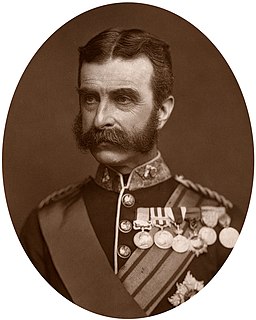
Frederic Augustus Thesiger, 2nd Baron Chelmsford, was a British Army officer who rose to prominence during the Anglo-Zulu War, when an expeditionary force under his command suffered a decisive defeat at the hands of a Zulu force at the Battle of Isandlwana in 1879. Despite this defeat, he was able to score several victories against the Zulus, culminating in the British victory at the Battle of Ulundi, which ended the war and partly restored his reputation in Britain.
Ernest Percival Rhys was a Welsh-English writer, best known for his role as founding editor of the Everyman's Library series of affordable classics. He wrote essays, stories, poetry, novels and plays.

William Henry Edgcumbe, 4th Earl of Mount Edgcumbe, GCVO, PC, DL, styled Viscount Valletort between 1839 and 1861, was a British courtier, Conservative politician, and Volunteer officer.
Pietro IV Candiano (925–976) was the twenty-second (traditional) or twentieth (historical) doge of Venice from 959 to his death. He was the eldest son of Pietro III Candiano, with whom he co-reigned and whom he was elected to succeed.
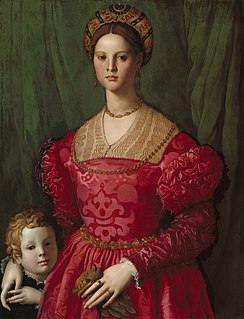
Maria de' Medici was the eldest child of Cosimo I de' Medici, Grand Duke of Tuscany and Eleonora di Toledo. She was a member of the famous Medici family.
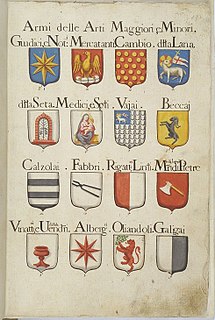
The guilds of Florence were secular corporations that controlled the arts and trades in Florence from the twelfth into the sixteenth century. These Arti included seven major guilds, five middle guilds and nine minor guilds. Their rigorous quality control and the political role in the commune that the Arti Maggiori assumed were formative influences in the history of Florence, which became one of the richest cities of late Medieval Europe.
Felicia Cornaro was the Dogaressa of Venice by marriage to the Doge Vitale I Michiel. She was politically active and exerted an acknowledged influence over the affairs of state. She was a strong supporter of the First Crusade.

Cymon and Iphigenia is an oil on canvas painting by Frederic Leighton, 1st Baron Leighton. The painting does not bear a date but was first exhibited at the Royal Academy of Arts, London, in 1884. The Art Gallery of New South Wales in Sydney, Australia, purchased it at a Christie's auction in London in 1976.

"Der Fischer" is a ballad by Goethe, written in 1779. Goethe's poem describes an exchange between a fisher and a mermaid who accuses him of luring her brood. As revenge, she enchants him with her song and pulls him into the water.

An Athlete Wrestling with a Python was the first of three bronze sculptures produced by the British artist Frederic Leighton. Completed in 1877, the sculpture was a departure for Leighton, and heralded the advent of a new movement, New Sculpture, taking realistic approach to classical models. It has been described as a "sculptural masterpiece" and as "possibly Leighton's greatest contribution to British art". Despite its indebtedness to the Classical tradition, it can be understood as one of the first stirrings of modern sculpture in Britain as well as in Europe. The Athlete was arguably the most influential piece of English sculpture of the 19th century.
The Bath of Psyche is an oil painting by Frederic Leighton, first exhibited in 1890. It is in the collection of Tate Britain.
Crenaia, the Nymph of the Dargle is an oil painting by Frederic Leighton, first exhibited in 1880. It is in the collection of Juan Antonio Pérez Simón.

The Fisherman and the Syren is an oil painting by Frederic Leighton, first exhibited in 1858. It is a composition of two small full-length figures, a mermaid clasping a fisherman round the neck. The picture is in the collection of the Bristol Museum & Art Gallery.
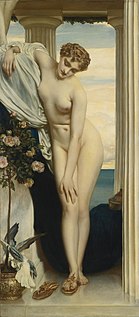
Venus Disrobing for the Bath is an oil painting by Frederic Leighton, first exhibited in 1867.

Actaea, the Nymph of the Shore is an oil painting by Frederic Leighton, first exhibited in 1868.

Winding the Skein is an oil painting by Frederic Leighton, first exhibited in 1878.

Nausicaa is an oil painting by Frederic Leighton, first exhibited in 1878.

The Music Lesson is an oil painting by Frederic Leighton, first exhibited in 1877.
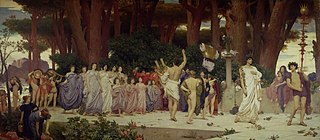
The Daphnephoria is an oil painting by Frederic Leighton, first exhibited in 1876.